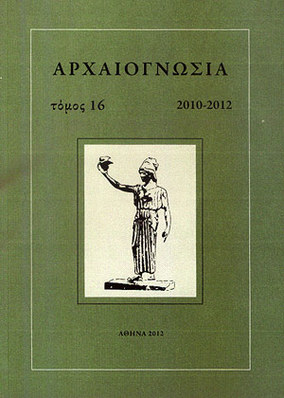Ο Τρωϊκός κύκλος στην προκλασική εικονογραφία της Ανατολικής Ελλάδας
Part of : Αρχαιογνωσία ; Vol.10, No.1-2, 1999, pages 11-50
Issue:
Pages:
11-50
Parallel Title:
The Troyan cycle in the preclassical imagery of East Greece
Section Title:
Μελέτες-Articles
Author:
Abstract:
The aim of this paper is to collect and comment on the scenes from the Trojan cycle that preoccupied East Greek artists. Some fifty scenes are presented in the order of the narrative development of the epic poems, starting from the Cypria through the Iliad, the Aithiopis, the Sack of Troy and culminating in the Nostoi including the Odyssey. Special attention is drawn to a little known polychrome Chian chalice from Pitane which, I think, should now be interpreted as the “Monomachy of Achilles with Memnon” from the Aithiopis and an attempt towards its reconstruction is ventured.The exploration of Trojan imagery in the East Greek region, or by the Ionian artists of the diaspora, such as the vase painters of the Caeretan hydriai and the Ionian Ricci hydria, demonstrates the variety of Archaic art even in the “provincial” schools. The problems and peculiarities discussed in detail under each heading perhaps allow the following general conclusions concerning the scenes:1. They certainly have no part in the avant-garde development of the time and, with the possible exception of the late Geometric stamps with “the Carrying of Achilles by Ajax” from Samos and Pithekussai, lag behind dramatically.2. They are never in step with the leading centres of Corinth, Athens, Laconia and the Cyclades, thus leaving untouched whole epics, such as the Tittle Iliad and the Ilioupersis, save for the “Sacrifice of Polyxena” on a Clazomenian sarcophagus, and of course a number of scenes from the other poems of the Trojan saga.3. They are pitifully small in quantity, partly because of the sparsity of excavated and published material, but mainly because of the predominance of other figurative and decorative styles in vase painting, which is the basic corpus of preclassical iconography.4. They are in no way inventive, with the possible exception of the “Judgement of Paris” on the west frieze of the Siphnian Treasury created by an artist from North Ionia, most probably Clazomenae. The scene undoubtedly owes its inspiration to the Clazomenians’ predilection for illustrating horses and chariots.5. In the East Greek context the Psychostasia motif on the Ricci hydria is unique, though perhaps under indirect influence.In short, from the imagery of East Greece alone, it would have been quite impossible to trace any complete understanding of the Trojan cycle. Nonetheless, a few scenes, especially from the Iliad, i.e. the “Odios Embassy to Achilles” on a Caeretan hydria, the “Euphorbos” plate from the South East region, and certain iconographical elements of the “Dragging of Hector’s body” on a Clazomenian hydria sherd, hint at good knowledge of that specific poem and at the same time contribute in an original manner to the overall concept and appreciation of preclassical iconography.
Subject:
Subject (LC):
Keywords:
αρχαιολογικοί χώροι, αρχαϊκή εποχή
Notes:
Περιέχει εικόνες και σχέδια., Η μελέτη αυτή ξεκίνησε από διάλεξη που έδωσε η Άννα Λαιμού στις 3 Μαρτίου 1994 για το Centre for Hellenic Studies στο King’s College του Πανεπιστημίου του Λονδίνου και αργότερα, στις 23 Ιανουαρίου 1995, στο Μουσείο Κυκλαδικής Τέχνης του Ιδρύματος Ν.Π. Γουλανδρή στην Αθήνα.




